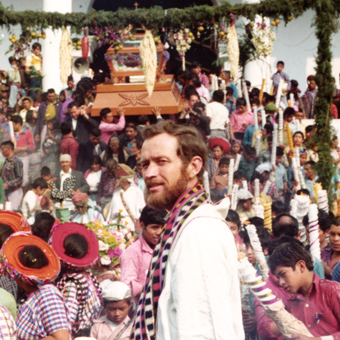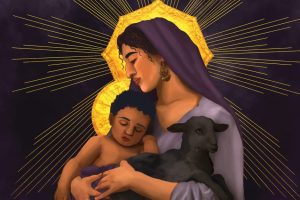On my first visit to Guatemala, I stayed with a priest who brought me to the neighboring village of Santiago Atitlán, where he told me the story of Father Stan Rother. The American missionary, caught in the middle of Guatemala’s civil war, wound up on a death list because the military government interpreted his charitable acts as subversive. Rother fled back home to Oklahoma for a brief exile but then decided to return to his parish. The pastor could not abandon his flock. “The shepherd cannot run,” he explained to friends.
Standing outside the colonial church of Santiago, my host explained how a short time later, on the night of July 28, 1981, three masked men entered the rectory. They found Rother in the downstairs den. He fought them—evidenced later by his bloodied knuckles—but he could not defend himself against their guns. They backed him into a corner and shot him in the face. He crumpled to the floor. One of the assassins bent over him and fired a fatal shot into Rother’s left temple. His blood spilled across the floor.
We entered the room. I touched my hand to the stain on the wooden wall, darkened by Rother’s blood. My host pointed out the bullet hole in the tiled floor. I knelt to run my finger along its jagged edge. That was my first brush with the mystery of a martyr’s faith.
I had read about martyrs, from the early disciples to later saints such as Father Maximilian Kolbe, the Polish priest who offered his life to spare another prisoner at Auschwitz. Their lives seemed distant histories compared to the immediate tactile connection I experienced with Rother’s memory.
Something else, seemingly more profound, struck me. The martyrs I’d read about seemed larger than life: Peter, the Rock upon which the church is built, or Agnes, willing to die as the bride of Christ at age 12. They were extraordinary—in other words, unlike me. As giants of faith, they could perform heroic acts beyond my understanding and capability.
But Rother, he was an ordinary guy. A farm kid from Oklahoma who liked to drink a beer and watch college football. I could relate to that. I could identify with him.
Initially he flunked out of the seminary. The Latin defeated him. Determined to fulfill his vocation, he made it through on a second chance, though he remained more comfortable rebuilding the school’s grotto than studying in the library. After ordination and several diocesan assignments, he volunteered to work at the Santiago Atitlán mission even though he didn’t know Spanish.
In Guatemala Rother found his niche. Determined to make his home in the culture, the guy who had struggled with Latin learned not only Spanish, but also managed to preach in the difficult local Mayan dialect, spoken by very few gringos. His faith and zeal as a missionary would not have him impose his beliefs but rather inspired him to walk alongside others.
He visited parishioners in their homes—often one-room shacks that housed a family of six or more—and sat on the dirt floors to break bread with them. He was moved to tears by the predawn Easter Vigil liturgies where Mayan customs animated Catholic tradition. He wore proudly the ancient scarf that native elders had bestowed upon him. He loved them, and they returned his love.
So it was that when the army occupied the village and men started to disappear, Rother aided the widows and orphans, even though it cast him as sympathetic to the opposition. He challenged the army’s commander about the disappearances. He sheltered those in danger. In short, he persisted in his ministry.
When his name showed up on a death list in the early months of 1981, he left Guatemala at his friends’ insistence. Me, I would’ve stayed in Oklahoma, where it was safe, but Rother couldn’t. His faith bade him return to his people, where he belonged. He would rather die in service of the Lord than spurn his pastoral duties to save his posterior. He returned for Holy Week.
That summer, during the village’s fiesta time, he celebrated Sunday Mass in his parish. During the Eucharistic Prayer, he raised the chalice and said, “Take this, all of you, and drink from it: this is the cup of my blood, the blood of the new and everlasting covenant. It will be shed for you and for all so that sins may be forgiven. Do this in memory of me.”
Two days later, he shed his blood in Christ’s memory.
In the moment of truth, he proved himself a man of extraordinary faith. If an ordinary guy can do that, perhaps I can, too. Rother has become my patron saint for facing life’s daily challenges. When I encounter my own fears, I pray to him for the courage he found to conquer his.
This article appeared on the August 2006 issue of U.S. Catholic (Vol. 71, No. 8, pages 46-47).













Add comment